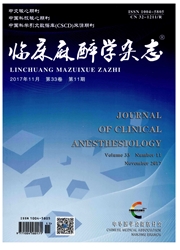

 中文摘要:
中文摘要:
目的探讨κ受体在芬太尼后处理和肢体远隔缺血后处理(RIP)心肌保护作用机制中的作用。方法将72只成年雄性SD大鼠随机均分为四组:模型组、芬太尼后处理组、肢体RIP组、芬太尼后处理和肢体RIP联合应用组。全部大鼠在体结扎冠状动脉左前降支(LAD)30rain和再灌注180min。在结扎LAD前5min,将每组再均分为A、B两个亚组,分别静脉输注生理盐水和-受体拮抗剂nor-binaltorphimine(nor-BNI)。再灌注180min时,测定血浆肌酸激酶MB同工酶(CK-MB)活性和血清心肌肌钙蛋白I(cTnl)浓度,采用伊文氏蓝和氯化三苯基四氮唑染色法测定心肌梗死面积(IS)。结果芬太尼后处理和肢体RIP均可显著降低心肌缺血-再灌注后的IS以及血清CK—MB和cTnI(P〈0.05),联合应用组心肌保护效果显著增强(P〈O.05)。结论κ受体参与芬太尼后处理的心肌保护作用,但未参与肢体RIP的降低进行梗死面积的保护作用。κ受体对于联合应用芬太尼后处理和肢体RIP降低心肌梗死面积方面的协同作用十分重要。
 英文摘要:
英文摘要:
Objective To investigate the role of κreceptor in the cardioproteetive effects by fentanyl postconditioning and limb remote ischemic postconditioning (RIP). Methods Seventy-two anesthetized male SD rats were randomly allocated equally into four groups (n= 18 in each group) : control group, fentanyl postconditioning group, RIP group, and combined fentanyl postconditioning and RIP group. Rat was opened chest and the left anterior descending coronary artery (LAD) was encircled with a suture to make a snare. All the rats received a 30-min ischemia by LAD ligation and a 180-min reperfusion by LAD open in vivo. Five mintes before LAD ligation, all the rats in each group were divided into the two subgroups the saline (subgroup A) or nor-binaltorphimine (nor-BNI) (subgroup B). Infarct size was determined by 2, 3, 5-triphenyltetrazolium chloride staining. The serum levels of creatine kinase isoenzyme MB (CK-MB) and cardiac troponin I (eTnI) in plasma were measured at the end of reperfusion. Results Both fentanyl postconditioning and RIP significantly decreased the infarct size, CK-MB and cTnI levels induced by ischemia-reperfusion(P%0.05), and these effects were enhanced by fentanyl postconditioning plus RIP (P〈 0.05). Conclusion The κ-opioid receptor is involved in the cardioprotection of fentanyl postconditioning, but not in RIP, and it plays an important role in the synergistic effect in combiaed fentanyl postconditioning and RIP.
 同期刊论文项目
同期刊论文项目
 同项目期刊论文
同项目期刊论文
 期刊信息
期刊信息
